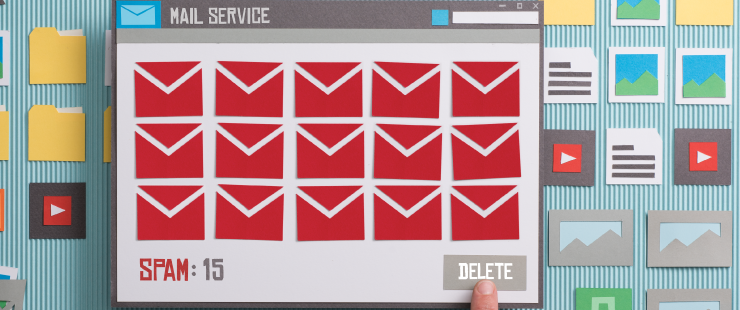Email Blacklist Check: what to do and how to avoid getting blacklisted
Having a good Sender Reputation doesn’t mean you don’t need an email blacklist check every once in a while.
Even righteous senders can be blocklisted sometimes, but this is a fact that people frequently don’t pay attention to. So, they undermine the importance of an email blacklist lookup.
Aiming at shedding more light on this topic and giving suggestions on how you can avoid getting blacklisted, we prepared this article with pieces of information about blacklists and email safety.
Read on and you will learn all about email blacklist check and the best practices in email marketing campaigns, which will help you improve your company’s results and reputation.
- What is Blacklisting?
- Why do senders get blacklisted?
- How to check if you’re blacklisted
- Email Blacklist Check (FAQ)
What is Blacklisting?
Blacklists are instruments that servers use to classify emails according to their chance of being spam.
In other words, it is possible to understand blacklists as filters, because they block spam and every kind of unwanted mail and keep them out of people’s mail, placing them in a junk folder.
That’s why, undoubtedly, they are relevant players in the online world. They make email exchange safer while they guarantee fake advertising campaigns won’t reach mailboxes, and also eliminate dangerous and ambiguous messages before they even reach real people.
Email exchanges are a much more enjoyable experience when we can count on blacklists. Everyone can (and should) agree with that.
Simultaneously, the very same blacklists can be taken as the obstacles that are between your emails and your target audience. This statement might sound confusing, but there is truth in it. Blacklists do their job perfectly, but the ways they operate and decide which emails are authentic and which ones are junk can be fatal even to well-intended messages.
Even if your domain is safe,you can be caught by blacklists, so you might need to run an email blacklist check and improve some policies on the manner you are sending your messages.
You should know there are two kinds of email blacklists:
- IP-based Blacklists: mailbox providers try to identify IP addresses that are sending dangerous emails, such as malware, viruses, botnet distributors, and spam, to many receivers;
- Domain-based Blacklists: in this category, blocklists use the sender’s domain to elaborate lists of domains related to spam (it doesn’t mean they actually send spam, but they have spam-friendly practices).
Remember that blacklists have no problem with senders with a good online presence and trustworthy reputation. Being blacklisted, despite sending legitimate messages, happens because emails and domains might be showing traits of a spammer.
Before we move on, let’s understand these traits and some of the reasons why nice senders can be a target to blacklists sometimes.
Why do senders get blacklisted?
Marketing strategists often ask themselves the following question: “Why are the opening rates decreasing while the bounce rates are increasing?” First of all, this question can have multiple answers, but such a case can be a clear sign that their domain or IP address might be blacklisted.
A more adequate question should be: “How did we get to this point”? When you know the causes, it is easier and faster to solve an undesired situation. Keep reading to know what practices can make you land email addresses in blacklists.
Sending emails to spam traps
This is a common outcome when lists are not clean (and full of invalid, fake, and disposable email addresses) or when methods of building responsive subscriber lists are questionable (such as buying contacts online).
Companies that don’t worry or don’t care about cleaning their lists, having safe strategies of acquiring contacts or getting an email blacklist check are likely to end up on blacklists.
The conclusion to be withdrawn from this scenario is that having a clean email list is an extremely important initiative to protect your deliverability.
Spam complaints
A usual but misleading thought that many marketing strategists have is about sending emails to as many people as possible to increase clickthrough rates and have conversions.
A point that these professionals are missing out on is regarding the fact that some of these people who are receiving the unasked for messages are going to mark them as spam.
Spam complaints are hurtful to deliverability rates, without mentioning the email address and domain can be eventually blocklisted because of them.
Sending messages only to your target audience, rather than forcing your emails into mailboxes, is the key to success.
Dirty mail lists
Many companies have several email lists to be used for marketing purposes. Sadly, some of them even buy full email lists online, trying to boost their range and reach more people easily and quickly.
What they don’t know is that lists that were bought online are full of fake and invalid email addresses. You can even find misspelled ones. Sending messages to them will do nothing but hurt your online reputation and make you get blocklisted.
Don’t buy mail lists, once they turn out to be dirty. This is a habit that you don’t need in your company. What you do need is to come up with your own lists, full of contacts that are interested in your messages and that are valid.
Another thing that you do need, despite creating your own list, is to usually clean them, so you can remove outdated information, unsubscribers, and invalid emails or temporary emails.
Typo traps and trigger words
While an innocent typo and spelling mistake won’t make you get blacklisted, it does become a problem when you have these errors excessively in your email lists.
Certain words are like triggers to blacklists. If you use them, there will be trouble. There is a long list of words you should avoid, especially the ones linked to suspicious offers, requests, and ads.
Be very careful about the words you choose to put in the email title, and also be mindful of the body of the message.
Finally, be attentive to typos in users addresses and don’t miss the opportunity of correcting them or adopting methods that are able to double check what people are typing into your registration forms, landing pages and newsletters.
Sender reputation
When we look into the topic of email marketing campaigns, what matters the most is your sender reputation, that is, the way people perceive your domain and online presence.
If your email and domain are frequently associated with spam or you have a low opening rate and high bounce reports, you might want to review and improve your sender reputation.
After running an email blacklist check and cleaning your contact lists, you will certainly be able to get your good reputation back and also upgrade how your brand is noticed online.
How to check if you’re blacklisted
It is possible to realize when a domain or email is blacklisted, but let’s understand how: First, more than realize, you will feel there is something wrong going on when you come across with:
- low opening rates;
- poor engagement;
- a huge number of bounced emails
- spam complaints.
Additionally, you can run an email blacklist check to verify if your domain and email were blacklisted. Checking all of the internet’s email blacklists and blacklists is impossible. However, you can check the main blacklists or use some tools that can be used to check if domains and IPs are blacklisted or do the email blacklist lookup, such:
- MXToolBox;
- Barracuda Reputation Block List (BRBL);
- Sender Score;
- SpamHaus.
Running these platforms are simple and fast. Most times, you will need to submit your email address or domain, click on the “lookup” or “‘check” button, and you are all set. Soon enough, you are going to have the answer you need, and if you were indeed blacklisted, you can start taking the right measures to gain your reputation back.
How to avoid getting blacklisted
Even if your messages are authentic, you can get blacklisted if you employ practices that are associated with spam attempts, for instance sending emails to invalid addresses and not using email validation. Check out some tips to staying away from being blacklisted.
Make an opt-in
Opt-in is a user registration where people fill out their required data and confirm this registration. You can even send a confirmation email to certify this entry is valid, in a method called Double Opt-In.
After the users confirm their registration, they are a part of your subscriber lists and you can send them emails safely because they allow you to do so. This way, you avoid being blacklisted.
You can even use an email verifier, such as SafetyMails, to make sure people are going to give you a real and valid email address. You can have a real-time API to check your forms and solicit changes if necessary (in cases of typos, and invalid data).
Remove bounces
Emails that can’t make it to their final destination will bounce back to you. It happens when you try reaching an invalid or a fake email account.
It can also happen when you hit a full mailbox or in case of an internet malfunction (either on the sender’s or receiver’s end).
Having excessive bounces will destroy your reputation, once you can be blacklisted because of this situation.
Sending emails only to real and responsive users, as well as having a clean email list will keep you away from accounts that may destroy your reputation and make sure your messages hit real mailboxes.
You need to know when you have to scrub your email lists and adopt the best practices to protect your domain.
Don’t buy emails
If you worry too much about numbers rather than quality, you might fall into the trap of buying emails.
This is a dangerous and pointless practice. Instead of that, we will stick to saying you have to avoid buying emails if you want to have a good reputation as a sender and not be included in public blacklists.
Focus on reaching people who are interested in what you have to say or your products and forget the idea that you need to send emails to every possible (and impossible) email address to have a lot of conversions and sales. Quality is always superior to quantity.
Verify email addresses
If you are watching your opening clicks take a dive or you are unhappy with your online performance overall, it might be a wake-up call for you to verify email addresses with an email checker.
Don’t be discouraged because of harmful email addresses. With the help of an email verifier, like SafetyMails, you can easily solve the problem of the performance below the average and, hence, improve your deliverability rates.
Now that you learn about email blacklist check, learn also how to boost your performance online and increase your opening clicks. SafetyMails can validate your mail lists and help you improve your deliverability rates.
Email Blacklist Check (FAQ)
Blacklisted is a term used when your email address or domain is appearing in public blacklists, such as SpamHaus.
These blacklists are ways to prevent spam from reaching receivers’ mailboxes. If you were blocklisted, it’s probably because some of your email sending techniques are spam-friendly, which calls for identifying these practices and avoiding them. Usually, some of the strategies you can have to avoid being blacklisted are:
. cleaning email lists;
. using email verifiers;
. reviewing typos;
. avoiding trigger words.
If you suspect a certain email is blacklisted, you should do an email blacklist check, that is, a software able to tell if an account is a sender of dangerous emails.
There are many email blacklist checkers online. They all offer an accurate and quick email blacklist lookup at public blocklists.
If you were blacklisted, you have to understand the reason why it happened and change this practice, in order to protect your deliverability and your reputation.
After you found out what caused the blacklisting (probably a dirty or outdated email list), you have to request your removal from this public blacklist.
Having good practices as a sender will be important to keep you away from these listings, such as making an opt-in (or double opt-in), removing bounces and invalid emails, never buying email lists and verifying your lists regularly.
If you are blacklisted, you will face problems regarding your deliverability and engagement with your customers.
The biggest issue is having problems when delivering emails to your audience, which will harm your conversion and sales.
Why is it important to implement an email verification service in your strategy?
When you build an email database, you surely want to have real people connected in your lists.
However, many people give a fake email address or an invalid one. They can simply make silly spelling mistakes during the registration process in your landing page or newsletters, for example.
SafetyMails has an expertise in prevent your whole strategy went to waste because you ended up with several addresses that are not fit to use. In other words, using our email verifier, your collected addresses are real, and can generate engagement.
In case of typos, the service can solicit corrections and reviews, making sure you don’t lose a promising lead. Everything happens in real-time and the email checker api is accurate and fast.
Would you like to know us better? Test now and check emails for free!
Choose SafetyMails email verification tool and see how easy it is to make sure no invalid or harmful addresses get to your subscriber lists!





